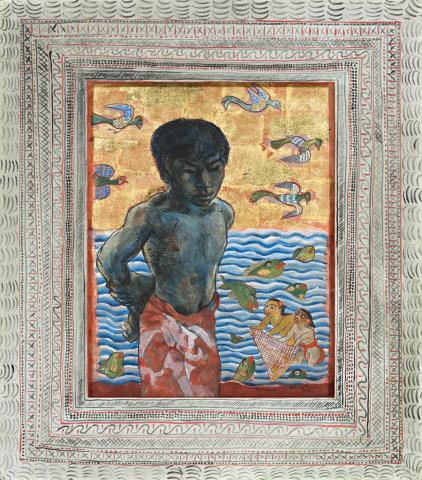THE LAGOON, c.1975
DONALD FRIEND
pen, ink, gouache, gold leaf on paper
The flat surrounding timber frame was made by Attilio and decorated by the artist.
69.0 x 47.0 cm
signed and inscribed lower right: The Lagoon. Donald Friend. / Bali
Donald Friend Retrospective, Art Gallery of New South Wales, Sydney, 9 February – 25 March 1990; National Gallery of Victoria, Melbourne,14 April – 6 June 1990; and Tasmanian Museum and Art Gallery, Hobart,26 June – 19 August 1990 (label attached verso)
Hawley, J., 'The bitter feud of Donald Friendand friend', Good Weekend: The Sydney Morning Herald, 29 October 1988, p. 51 (illus.)
Pearce, B., Donald Friend, 1915–1989: Retrospective, Art Gallery of New South Wales,Sydney, 1990, cat. 95, p. 115 (illus.)
For Donald Friend, Bali was the realization of a dream. His life there became legendary, and much of it was true. In addition to his island paradise, there were solo exhibitions in Paris, an English film crew recorded his sybaritic ways, and the roll call of famed visitors numbered among them Queen Soraya of Persia, Mick Jagger, the Duke of Edinburgh and Gore Vidal. The enchantment of Bali had captured Friend from his first visit. Its spell was so great that he decided to settle, building a house at Batujimbar on the beach of Sanur. Buildings grew in Friend's adaptation of the Balinese style; houseboys served his various needs, and gardeners tended the gifts of nature. The families of the retinue 'in turn became his family'.1 He even had his own small gamelan, that traditional Balinese musical ensemble with its variety of instruments of metallophones, xylophones, to drums, gongs, bamboo flutes, and strings. Amid all this and his antique collection, he lived 'like a benevolent feudallord'.2 As a lover of islander life, he embraced its superstitions and moralities, became a collector/scholar of Balinese art and wrote a book on Balinese bronzes.
In another book, Donald Friend in Bali published in England in 1972, he wrote of Bali: 'The island itself for years had been a favourite part of my imagination's geography'.3 His passionate embrace of Bali is captured in his own words:
'Pillared bamboo glades shaded charming kampongs. Ducks and geese abounded. There were no discernable signs of the orient's brooding mystery, nor that fantastic melancholic inertia writers tell about. Quite to the contrary - every leaf shimmered green and yellow, quivering with a life that filled one's heart with lightness. Foliage arched over village streets where children scampered out of dappled light into carved doorways, laughed, peered, waved at us. Showers of scarlet flowers flowed from the walls, Ancestor-shrines extended blessings to prosperous houses.'4
In The Lagoon, c1975, Friend responds to this tropical abundance of colour, life, and the physical dignity and attraction of the native peoples. The model, surely one of his houseboys, is drawn with all the masterly skill Friend had at his fingertips, the sensitivity of line and painterly flow matched by the sensitivity of the concept itself. West meets East in the placement of the figure against a backdrop of patterned waters, flowing rhythms of wings and waves, of motifs inspired by the art around him. The illusion of the three-dimensional contrasts with the decorative flatness, acting as a metaphor of the differences between the cultures, enriched by the gold leaf of plenitude in celebration of the exotic.
1. Pearce, B., Donald Friend, 1915-1989: Retrospective, Art Gallery of New South Wales, Sydney, 1990, p. 17
2. Ibid., p. 148
3. Friend, D., Donald Friend in Bali, Collins, London, 1972, p. 9
4. Ibid., pp. 29-30
DAVID THOMAS
